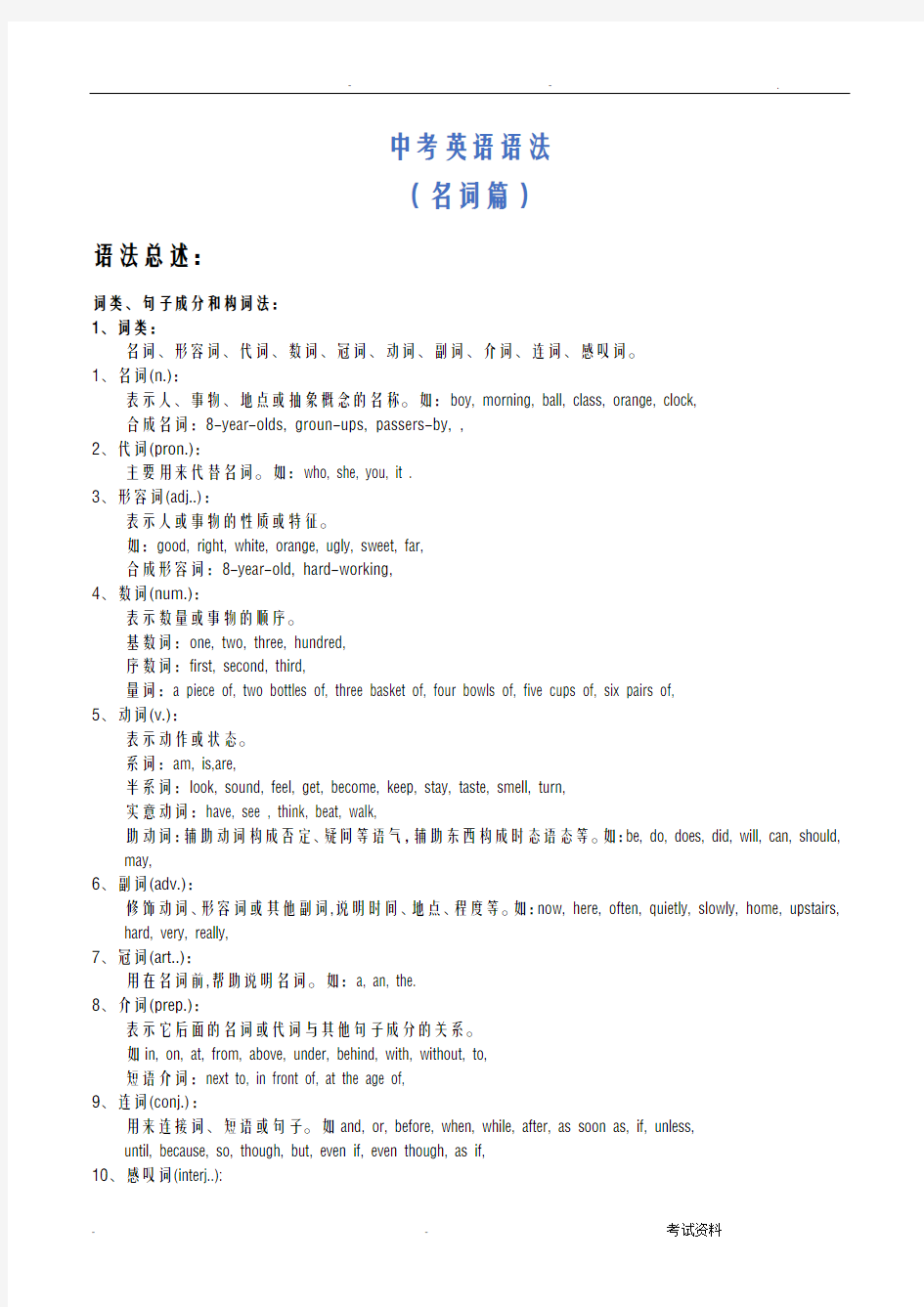

中考英语语法
(名词篇)
语法总述:
词类、句子成分和构词法:
1、词类:
名词、形容词、代词、数词、冠词、动词、副词、介词、连词、感叹词。
1、名词(n.):
表示人、事物、地点或抽象概念的名称。如:boy, morning, ball, class, orange, clock,
合成名词:8-year-olds, groun-ups, passers-by, ,
2、代词(pron.):
主要用来代替名词。如:who, she, you, it .
3、形容词(adj..):
表示人或事物的性质或特征。
如:good, right, white, orange, ugly, sweet, far,
合成形容词:8-year-old, hard-working,
4、数词(num.):
表示数量或事物的顺序。
基数词:one, two, three, hundred,
序数词:first, second, third,
量词:a piece of, two bottles of, three basket of, four bowls of, five cups of, six pairs of,
5、动词(v.):
表示动作或状态。
系词:am, is,are,
半系词:look, sound, feel, get, become, keep, stay, taste, smell, turn,
实意动词:have, see , think, beat, walk,
助动词:辅助动词构成否定、疑问等语气,辅助东西构成时态语态等。如:be, do, does, did, will, can, should, may,
6、副词(adv.):
修饰动词、形容词或其他副词,说明时间、地点、程度等。如:now, here, often, quietly, slowly, home, upstairs, hard, very, really,
7、冠词(art..):
用在名词前,帮助说明名词。如:a, an, the.
8、介词(prep.):
表示它后面的名词或代词与其他句子成分的关系。
如in, on, at, from, above, under, behind, with, without, to,
短语介词:next to, in front of, at the age of,
9、连词(conj.):
用来连接词、短语或句子。如and, or, before, when, while, after, as soon as, if, unless,
until, because, so, though, but, even if, even though, as if,
10、感叹词(interj..):
表示喜、怒、哀、乐等感情。如:oh, well, hi, hello
2、句子成分:
主语、谓语、宾语、定语、状语、表语、宾语补足语。
1、主语是句子所要说的人或事物,回答是“谁”或者“什么”。通常用名词或代词担任。如:I’m Miss Green.(我是格林小姐)
2、谓语动词说明主语的动作或状态,回答“做(什么)”。主要由动词担任。如:Jack cleans the room every day. (杰克每天打扫房间)
3、表语在系动词之后,说明主语的身份或特征,回答是“什么”或者“怎么样”。通常由名词、代词或形容词担任。如:My name is Ping ping .(我的名字叫萍萍)
4、宾语表示及物动词的对象或结果,回答做的是“什么”。通常由名词或代词担任。如:He can spell the word.(他能拼这个词)
有些及物动词带有两个宾语,一个指物,一个指人。指物的叫直接宾语,指人的叫间接宾语。间接宾语一般放在直接宾语的前面。如:He wrote me a letter . (他给我写了一封信)
有时可把介词to或for加在间接宾语前构成短语,放在直接宾语后面,来强调间接宾语。如:He wrote a letter to me . (他给我写了一封信)
5、定语修饰名词或代词,通常由形容词、代词、数词等担任。如:
Shanghai is a big city .(上海是个大城市)
6、状语用来修饰动词、形容词、副词,通常由副词担任。如:He works hard .(他工作努力)
7、宾语补足语用来说明宾语怎么样或干什么,通常由形容词或动词充当。如:They usually keep their classroom clean.(他们通常让教室保持清洁) / He often helps me do my lessons.(他常常帮我做功课) / The teacher wanted me to learn French all by myself.(老师要我自学法语)
☆同位语通常紧跟在名词、代词后面,进一步说明它的情况。如:Where is your classmate Tom ?(你的同学汤姆在哪里?)
3、构词法:英语构词法主要有:合成法、派生法和转换法。
1、合成法:如:spaceship, headache, basketball, playground等等。
2、派生法:
(1)派生名词:①动词+er/or ②动词+ing ③动词+(t)ion ④形容词+ness ⑤其他,如:inventor, learner, swimming, congratulation, kindness, carelessness, knowledge
(2)派生形容词:①名词+y ②名词+ful ③动词+ing/ed ④friendly ⑤dangerous ⑥Chinese; Japanese ⑦English ⑧French ⑨German ⑩国名+(i)an 如:snowy, sunny, hopeful, beautiful, interesting, follwing, daily(每日的),nervous, delicious
(3)派生副词:①形容词+ly ②其它,如:slowly, angrily, full→fully, good→well, possible→possibly等等。
3、转换法:
(1)形容词→动词,如:dry(干燥的)→dry(弄干), clean(干净的)→clean(打扫,弄干净),等等。
(2)动词→名词,如:look, walk, rest, work, study, swim, go, talk等等。
(3)名词→动词,如:hand(手)→(传递),face(脸)→(面对)等等。
(4)形容词→副词,如:early→early, fast→fast等等。
(5)副词→连词,如:when(什么时候)→(当……时候),等等。
(6)介词→副词,如:in(到……里)→(在里面;在家),on(在…上)→(进行,继续),等等。
名词篇:
1、专有名词是个别的人、地、物、团体、机构等的专用名称。
专有名词中实词的第一个字母要大写。如:Jilin, Tom, China,
(1)零冠词,如Yale University,Beijing Railway Station,是由专有名词+普通名词组成,往往为并列关系。
(2)定冠词,如the United States,the Great Wall,由形容词+普通名词组成。
(3) 姓氏名如果采用复数形式,则表示该姓氏一家人(复数含义),如:the Greens( 格林一家人)。
2、普通名词是许多人或事物的共有名称。
普通名词又可进一步分为四类
1) 个体名称: 表示单个的人和事物。
house 马car 汽车room 房间apple 苹果fun 风扇picture 照片
2) 集体名称: 表示一群人或一些事物的名称。
people 人们family 家庭army 军队government 政府group 集团
3) 物质名词:表示物质或不具备确定形状和大小的个体的物质。
fire 火steel 钢air 空气water 水milk 牛奶
4)抽象名词:表示动作,状态,品质或其他抽象概念。
labour 劳动health 健康life 生活friendship友情patience耐力
3. 普通名词又分为可数名词和不可数名词。
可数名词是可以用简单的数词进行计数的名词,如:box, child, orange;
不可数名词是不可以用简单的数词进行计数的名词。如:water, news, oil, population, information .
4、英语可数名词的单复数:英语可数名词有单数和复数两种形式。
5、名词所有格:
名词在句中表示所属关系的语法形式叫做名词所有格,相当于物主代词,在句中作定语、宾语或主语。所有格分三种:一是名词词尾加’s构成,二是由介词of加名词构成。前者多表示有生命的东西,后者多表示无生命的东西。三是双重所有格。
有些表示时间、距离、度量衡、价值、自然现象、国家、城镇等无生命东西的名词,也可以加's构成
Whose pen is this? It's Tom's.这是谁的钢笔?是汤姆的。
The bike is not mine, but Tom’s.这辆自行车不是我的,是Tom的。
3. of所有格的用法:
用于无生命的东西:the legs of the chair, the cover of the book, a map of the world , the story of a hero , the windows of the room , the title of the film
用于有生命的东西,尤其是有较长定语时:the classrooms of the first-year students
某些of所有格和‘s所有格可以互换。
the son of a poor peasant=a poor peasant‘s son一个贫农的儿子
但有时含义却不相同,请比较下面的例子:
an old woman's story(一个老妇人讲自己的身世)
the story of an old woman(别人讲一个老妇人的身世)
4. 双重所有格
此外,不定冠词、数词、某些不定代词(some, any, many, no, few等)以及which等限定词,采用of所有格或双重所有格形式。例如:
most of the students学生中的大多数
three of them他们中的三个人
I like reading some books of his.我喜欢读他的一些书。
Which book of Qiong Yao’s do you like best?你最喜欢琼瑶的哪一本书?
5. 's所有格、of所有格和双重所有格三者之间的细微区别
请仔细比较下面三句话:
1.She is Mary's brother's friend.
2.She is a friend of Mary's brother.
3.She is a friend of Mary's brother's.
1句用的是's所有格,侧重说明她和Mary的哥哥是朋友关系,突出friend一词。
2句用的是of所有格,侧重说明她和Mary的哥哥是朋友关系,强调突出了Mary's brother。
3句用的是双重所有格,侧重说明Mary哥哥的朋友不止是一个,她只是其中的一个。
6、名词或代词作主语时和谓语之间的单复数的一致问题:
1、谓语和谓语基本保持单复数的一致,即:主语是是单数或者不可数名词时,谓语动词用单数形式。主语是复数时,谓语动词用复数。如:The computer was a great invention.(计算机是个了不起的发明)The water in the glass is very cold.(玻璃杯里的水很冷)。The students are working hard.
2、集体名词(如family, class, team, group, row, police, school等)做句子主语时,
如果表示整体概念,则谓语用单数形式,如:Class Three is a very good class.(三班是好班)
如果表示其中的所有成员时,则谓语用复数形式,如:Class Three have a map of China.(三班有张中国地图)
3、Chinese, Japanese, fish, sheep, people等表示单个时谓语用单数,表示许多时,谓语用复数。如:There is
a sheep in the yard.(院子里有只绵羊) / There are some sheep in the yard.(院子里有一些绵羊)
4、maths, news等虽然有s结尾,但不是复数,因此谓语仍用单数:The news is very exciting. (这个消息令人兴奋)
5、glasses, shoes, socks, trousers, gloves等名词往往用复数形式,故谓语用复数。如:
The trousers are very cheap and I want to take them.(裤子很便宜,我想买)